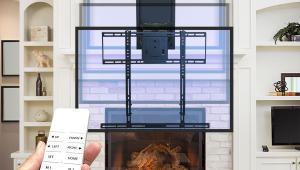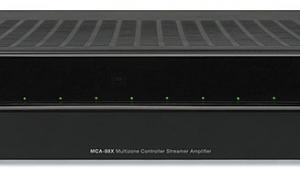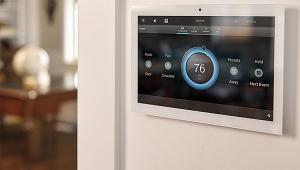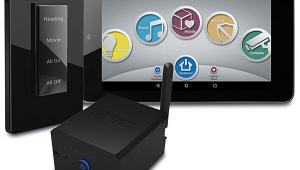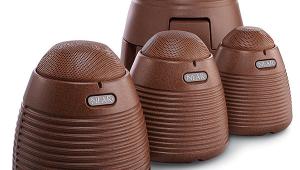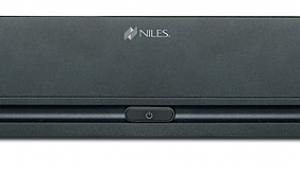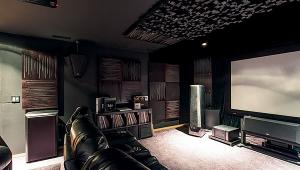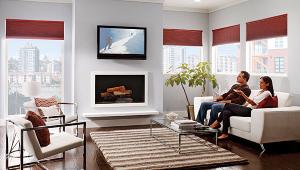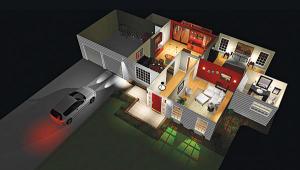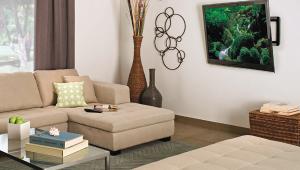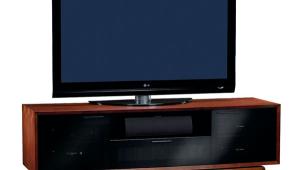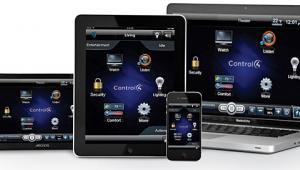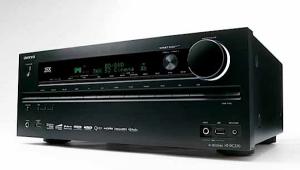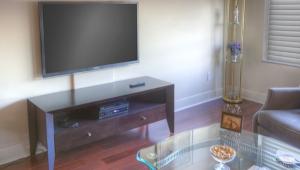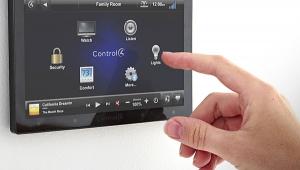The Really Great Outdoors: Part 2
 System 2: $25,914 to $35,180
System 2: $25,914 to $35,180
Screen
The following is an adventurous concept that's not for everyone. I'm going to design an outdoor system centered around a projector and a 9-foot-diagonal, tensioned, motorized screen. The trick is that the projector is inside the den, but the seating is both inside and outside. That's right: The outdoor seating is on the other side of the screen. How can that happen? Stewart Filmscreen makes two materials called Lumiflex 50/50 and Ultralume that display a projected image on both sides of the screen. So, you simply position the motorized screen cabinet in the interior above a sliding glass door or French doors (providing this works for the interior floor plan). You open the doors, drop the screen, and reverse the image in the service menu. Voilà: the key to a fantastic, real outdoor theater. As long as the audience is seated in a semicircle and not in rows, everyone will be able to see the entire screen. Both the interior and exterior seating should be about 12 feet from the screen.
Custom installers and dealers for Stewart can order both Ultralume and Lumiflex 50/50 in a variety of frames and motorized cans. Stewart carefully explains that, with this pearlescent screen material, off-axis performance and color fidelity do not approach normal Stewart image quality. These materials have a grain that adds a parchment-like quality to the image. But, again, I don't care. We're breaking quite a few rules to achieve this outdoor-theater concept, anyway. And, besides, this application is about enjoyment, not ultimate image quality. Plus, a little graininess goes a long way if you like historical dramas or old black-and-white movies. Try playing some video games on this rig. It's a blast.
Projector
To produce a viable image on this 1.0-gain screen, you need some brightness. The Panasonic PT-DW5000U single-chip DLP provides a stated 4,500 lumens (in dual-lamp, high-power mode) or 2,250 lumens (with the dual lamp set on long-life mode). It's a 1,280-by-768 projector. In my fictitious den system, the projector's throw distance is 14 feet from the screen, which requires the ET-DLE100 1.3:1-to-1.8:1 lens. I've been familiar with Panasonic's professional line of projectors for many years. I don't own a projector, but, if I were shopping, I'd seriously consider this unit. It features liquid cooling, a dust-tight cabinet, and a 2,000:1 contrast ratio, plus it's very well designed and built. With the lens and mount, it's $14,575.

A second projector to consider is the Marantz VP12S4 single-chip DLP. Its 700 ANSI lumens is not as bright, but its contrast ratio is a stated 4,500: 1, which will provide great dark-to-light detail throughout the gray scale. This is a 1,280-by-720, 16:9 projector. With a built-in lens, it is a comparative performance bargain at $11,499 (with mount).
Speakers
Now, to make this outdoor projector/screen system work, you'll need to mount front-channel speakers above the screen on the outside (the only logical place). This will mean either a flush-mounted or box-speaker LCR array, of which there are quite a few on the market. System 2, by its large-screen nature, needs big, robust audio, at least as much as you can get away with for an outdoor system. The James loudspeakers caught my attention at the Electronic House Expo. The front-channel speakers are the 82-SDX 8-inch outdoor two-way in-walls. With a 45-Hz (+/– 3 dB) lower frequency response, they produce some sonic body depth, which is sorely needed in an outdoor environment. Without installation, three speakers are $4,185.
For the surround channels, check out the James 103T-70 planter speaker ($2,695 each). It's a serious 80-pound component. The 10-inch weatherproof woofer, horn midrange, and 1-inch tweeter are housed in marine-grade, weather-treated mahogany and solid teak. The frequency response perfectly matches the front-channels' 45 Hz to 20 kHz for full-frequency reproduction.
As a clever alternative, I like the SoundScape mushroom ATS-360. It disperses sound 360 degrees via a full-range 8-inch driver. The poly enclosure is warranted for 10 years, but the manufacturer claims it will last a lifetime. The question is, whose?
And now for the piéce de résistance. It's so rare to find a truly novel product that actually makes sense in an unlikely way. The James Sub-Terranean model 101-STP subwoofer ($2,795) is one. It is a direct-burial system with a 10-inch high-excursion driver mounted in an aircraft-aluminum enclosure. The Model Six 1,200-watt rack-mount amplifier is also included. The tube port pops above the ground. Frequency response is 20 Hz to 120 Hz, and it gives new meaning to the term earth-shaking bass. It remains to be seen whether this is a good weapon against rodents. As I mentioned before, whatever subwoofer and surround-channel speakers you choose, run the wire through conduit. I've had gardeners accidentally chop up my direct-burial cable. Live and learn.
Remote Control
With a tricked-out system like System 2, you will quickly exceed the capacity of a garden-variety remote control. The numerous components and functions of an advanced system require a no-nonsense remote control. Available through authorized Crestron dealers/programmers, the Crestron WPR-48 handheld RF remote-on-a-rope ($700) is waterproof, which the owner's manual defines as submersible to a depth of 1 meter for 30 minutes. But it's not the nine-button, 48-function handheld that is the key. We need to provide a system processor, which would live near the components. There are two that could fit the bill. The first is the Crestron MP-2 Media Manager ($1,400), which has sufficient inputs for a basic standalone A/V system (two RS-232, four IR serial, four I/O, and four low-voltage relay ports). If you have quite a few A/V components aside from what's outside, then you might look at the model AV2 ($2,700), which is one of their core processors.
Submerged Tunes
As long as you are underwater with the remote, you might as well listen to something. The Electrovoice UW30 ($335) is a true underwater speaker. Its power handling is 30 watts RMS. You'll need to use it with a "wet niche" back-can by Paragon Aquatics ($200). It comes in a pool-blue color and is perfect for listening to Handel's Water Music.
System 2 (Minimum, Maximum Price)
Screen $4,300-$4,300
Projector, Lens, and Mount $11,499-$14,575
Front Speakers $4,185-$4,185
Surround-Channel Speakers $500-$5,390
Subwoofer $2,795-$2,795
Remote Control and Processor $2,100-$3,400
Underwater Speaker/Back Can $535-$535
Approximate Price (excluding tax, labor, parts, programming) $25,914-$35,180
For the record, I strongly recommend that you use a professional installer with expertise in outdoor applications. Many of these products are only available through the custom-installer channel and are not available off the shelf at big-box stores.
Safety
• Follow all building and safety codes. Use experienced, licensed professionals.
• Run all speaker- and line-level wire in PVC conduit (seal ends). Put all components and outdoor wiring on a separate circuit of sufficient amperage.
• Use a ground-fault circuit interrupter (GFCI).
• Never touch components with wet hands.
• Keep electrical cords away from toddlers or pets. Teach children at an early age about electricity and the importance of practicing electric safety.
• Don't use extension cords as a substitute for fixed wiring. Cover electrical outlets you're not using with plug protectors.
• Stay clear of substations and power lines. Keep radios, TVs, and other electrical appliances away from your swimming pool or hot tub.
• Don't operate your system in inclement or wet weather.
- Log in or register to post comments
